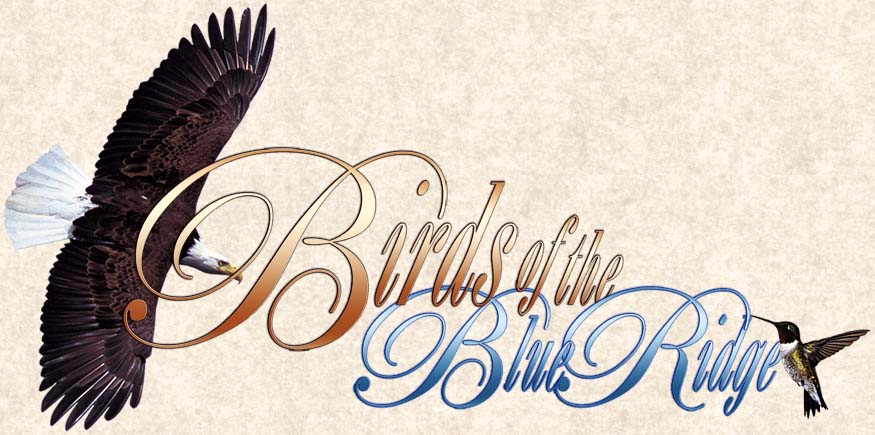
They paint the skies with their beauty and grace. Both mysterious and elusive they dwell within the confines of a complex and diverse world of mammals, humans and marine life, set apart and classified by their uniqueness. The wonders of their contributions to the scheme of life are essential to our own existence, pollinating the earth along with bees’ butterflies and moths. The exotic beauty of their colorful feathers has added to the sense of style and decoration to all civilized cultures. By inspiration they’ve taught the human race to fly, reaching for the moon and beyond. Plus they’re quite a delicacy on the banquet table.
Some paleontologists speculate that they are the actual decedents of the mighty dinosaurs that once ruled the earth long before our species evolved. What we do know is that they are our companions, nonetheless as essential as we humans who pride ourselves as rulers over the dominion of this earth. They have been revered in some civilized cultures and cursed at times by the agricultural societies.
The chosen symbol of our great nation is the mighty eagle, representing strength, freedom and endurance, capable of overcoming obstacles, prevailing to great heights with a sense of true purpose and perseverance unlike any other. Characterized under this symbolic bald eagle emblem stands a nation tried and true, able to reach beyond its grasp with a confidence that comes from a sense of self-assurance in democracy and greatness.
Yet in our greatness as a unified country, we the people of our nation have often been vulnerable to our lack of foresight when it comes to our own self-preservation and those species that are entrusted to our care. Due to pesticides in our own food supplies as well as pollutants in our waters, we along with other life forms are on the edge of self-imposed extinction. There is a great concern regarding, lost habitats for animal breeding grounds, bird nesting and as well as a serious need for overall preservation. Open spaces are getting filled in, deep rich forestlands are being opened up and wetlands are drying out, all for the sake of progress.
Fortunately, the U. S. National Forest and parklands take these issues seriously and are holding important ground over this concern but it is the private lands that need proper management.
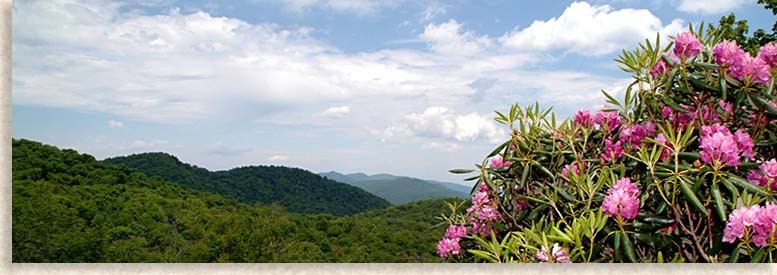
The Blue Ridge-Smoky Mountains of the Southern Appalachian Mountain range are one of these significant natural wilderness areas. Here several national forests, national parks and state parks are conjoined creating a massive wilderness that is ideal for wildlife, but only if it is kept that way. This mountainous region of the southeastern United States is like a natural biosphere where one can enjoy and appreciate the many facets of its diverse wildlife.
Though many species of wildlife lodge here, it is our fine-feathered mountain 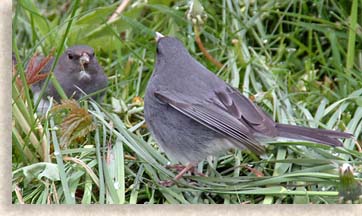 bird friends that are the focal point of this Blue Ridge Highlander feature story. These ancient mountains have provided a nearly perfect, safe haven for the continued life journey of these winged wonders. If taken for granted even this natural mountainous landscape stands a chance of losing all it protects thru irresponsible neglect and carelessness.
bird friends that are the focal point of this Blue Ridge Highlander feature story. These ancient mountains have provided a nearly perfect, safe haven for the continued life journey of these winged wonders. If taken for granted even this natural mountainous landscape stands a chance of losing all it protects thru irresponsible neglect and carelessness.
Keep in mind, before the U.S. Agriculture Department stepped in and created the National Forestry, 80% of this southern mountain forest were logged leaving a wasteland behind. The habitat has returned under their care, but times have change since those logging days presenting new problems, with pesticides and pollutants now in abundance and a greater demand of land by the private sector.
Today, individual as well as organizational efforts have brought the co-existence of humans and birds to the forefront. The admiration and concern for these aerial acrobats and their continual survival has motivated greater care and stiffer laws concerning their personal welfare, which often directly contributes to land preservation.
Before the 20th century, birds were considered commonplace, just another part of the food chain. They were hunted for their culinary delights, trapped for their exquisite exotic feathers, admired for the beauty of their songs, and depicted in more recent artworks as well as those dating back thousands of years.
Until the last century the abundant bird species saw no particular threat to their personal survival other than general hunting and the natural elements. Taken for granted, many birds have now become extinct while many others are on an endangered species list that continues to grow.
With the unknowing help of three historic individuals, we have begun to right the wrong by becoming more conscientious concerning the future welfare of our feathered companions. Of these three naturalist pioneers, there is one whose name is synonymous with bird life, John James Audubon (1785-1851.)
Audubon didn’t start the preservation movement; at the time there was no concern about the extinction of birds. He was more so a naturalist and a hunter, than a trained zoologist. He is credited as the first to use banding to  recognize bird migration and nesting. Audubon also documented the birds of North American through his artwork. John was a very talented artist, he loved the beauty of bird life and successfully captured it’s living essence.
recognize bird migration and nesting. Audubon also documented the birds of North American through his artwork. John was a very talented artist, he loved the beauty of bird life and successfully captured it’s living essence.
Born in Haiti in 1785 out of wedlock to a French naval officer (sea captain) and a chambermaid (his mother died during a slave rebellion.) John spent his youth in France, raised by his stepmother. During his youth, John developed an interest in drawing birds.
His father was a plantation owner who owned lands in the New World (America.) At the age of 18, John’s father sent him to his American plantation and estate (Mill Grove) to tend to his property and business affairs. The move was also to avoid Napoleon’s recruitment for young able body men to fight his wars. It was at the Mill Grove estate that John met his wife Lucy and conducted the first known bird-banding experiment in North America by tying colored string around the legs of Eastern Phoebes. The experiment confirmed birds do return to the same nesting sites each year.
After some personal success, hard times and bankruptcy, John was forced into early retired from business life in 1819. Utilizing his skills and talents John worked as a portrait artist while his wife worked as a governess and tutor.
Weary, John and a young assistant set out into the wilderness with nothing more than his gun, art supplies and limited provisions, living off the land while he documented American birds for his collection.
In 1826 he sailed to England with his partly finished collection and became an overnight success as the “The American Woodsman.” With 435 life-sized bird portraits, John acquired an engraver, Robert Havell of London, to publish his bird illustrations, this book is known as The Birds of America.
John continued his work with more artworks being publishing; his two sons and naturalist John Bachman later helped John with his publications. Drawing fame and recognition from his unique talent as the American Bird Artist brought John into the limelight. He is not considered the first of the American bird artist. Both artist and naturalist Gilbert White (1720-1793) and Alexander Wilson (1766-1813) predated John James Audubon, though it was John who dominated the attention of American bird lovers.
John James Audubon was quite a colorful character; he was an adventurer and capable hunter who claimed to have hunted with Daniel Boone. Their hunting expedition could have possibly placed them in the Blue Ridge Mountains considering the mountain town of Boone, in Watauga County North Carolina was one of Daniel’s old stomping grounds.
In 1887, thirty-six years after John’s death, the Audubon Magazine printed its first publication in honor of its John's namesake and accomplishments. Over 120-years later the Audubon Magazne is still popular bearing his name as an icon.
The John James Audubon name has continued to inspire the daily lives of countless bird lovers through the National Audubon Society. John had little to do with the founding of the society, though his wife inadvertently did. John’s widow, Lucy Audubon, once tutored one of the actual founders of the Audubon Society, George Bird Grinnell. George found John’s work to be unique and inspirational, the Audubon society was incorporated in honor of John’s renowned name in 1907.
Today, John James Audubon’s original art prints and books are still highly prized amongst bird enthusiast, a collection that sparked a movement toward bird watching and bird preservation throughout the world.
The Blue Ridge Mountains are one of the most diverse regions for bird species in the eastern United States due to its climate. Mild summers and winters draw native and migratory birds to its unique typography. Its waterways, thick forest and mountain heights provide ideal nesting and foraging sites for a large number of bird species.
Birds mostly found migrating and nesting in the north and southeastern United States can be found here in the Blue Ridge Mountains due to the cooler mountain air at higher elevations. Coastal birds find their way here to the mountains due to the abundance of fresh water fish and hatcheries, making easy pickings’ for wadding birds, waterfowls or predator birds diving for a fresh catch.
Here in the Blue Ridge Mountains, the high bluffs, dramatic cliffs and rocky overhangs draw large predators birds such as, eagles, falcons, hawks, buzzards and owls. The woodlands and forest are ideal for songbirds whose songs fill the air from the tops of ancient trees to the underbrush along the forest floor. Wild Turkeys explore the forest grounds and open meadows in search of food sources.Wild Turkeys explore the forest grounds and open meadows in search of food sources. Wild Turkeys explore the forest grounds and open meadows in search of food sources.
To see a flock of turkeys roaming the open fields is quite a sight, they look more like a small two-legged herd than a flock, usually led by one or more male-cocks referred to as Tom Turkeys. They are a strange looking species; I imagine them resembling a miniature herd of docile dinosaurs grazing on an open landscape.

After the bird-art craze of the mid to late 1800’s, the naturalist along with the general public catapulted this passion into a new pastime, recreational bird observation. This new segment of society was referred to as the “bird watchers. At first bird watching was a fun recreation that got folks out into the open air in search of frequent and rarely seen birds. With detailed full colored illustrations by John James Audubon, Gilbert White and Alexander Wilson bird enthusiast of the mid to late 1800’s could identify the various American bird species on their own.
What we know today as “bird watching,” actually began in Great Britain in 1880 and was followed by the United States and then into Germany, Switzerland, the Netherlands and Scandinavia before traveling the rest of the globe. It was out of this growing interest that the Audubon Magazine and the Audubon Society found it place.
It wasn’t until the mid 20th century that the movement really began to burst out due to the improvements in optics for binocular lenses, a vital tool for bird watching. The works of Roger Troy Peterson’s “Field Guide to the Birds,” published in 1947 became the guide for most bird watchers, giving field marks for all the North American birds that are found east of the Rocky Mountain divide.
Bird watching has grown in popularity because it is a very interesting and inexpensive recreation that takes one outdoors for a little fresh air and exercise. All you need are binoculars, a field birding book to identify sighted birds, a note pad or book for documenting time and place of sightings, a comfortable pair of walking shoes and a camera to capture the event.
I recommend using a camera with a telephoto lens, a monopod to steady the lens and shooting at a relatively high shutter speed, birds often move quickly, always foraging, keeping a safe distance from any suspected danger.
Bird watching can take you to exotic places, as well as locations near your home or even your own back yard. Hiking, driving tours or just sitting in a lawn chair outdoors can bring you into contact with these beautiful winged creatures. Bird watching can be as easy as setting out a bird feeder in the yard and enjoying all the birds it will attract.
If you’re a neighborhood bird watcher you’ll soon discover your feathered neighbors are here for the long haul just like you, after a while you’ll become so familiar with them you’ll recognize many of them like your own family pets.
Of all the bird species, it is the songbirds that are most numerous. Thousands of these songbird species migrate to and through these mountains annually. Songbirds provide the natural symphonies of our great outdoors. Their music is part of the fine intelligent designed we all benefit from. In the warm season, just before the sun rises they begin the song as though they were welcoming the sunlight as it breaks along the horizon. The songbird’s natural nesting grounds are the trees of the forest. The loss of forestlands, whether due to logging or forest fires are removing natural the nesting area for many of the migratory songbirds that visit these mountains each year, their numbers are noticeably decreasing. One way of helping the songbird’s plight, other than leaving the trees alone, is to put out bird feeders. When installing bird feeders be aware of the squirrels, bears and other climbing critters that are known to raid bird feeders, be sure to place your feeders in an appropriate manner to avoid scavenger problems.
Though the love of bird watching began as an innocent fun pastime, the movement has become essential during the second half of the 20th century due to pollutants, pesticides, lost wetlands, and habitat loss, over hunting and poaching. Between wildlife observers and wildlife agency’s stricter laws, a conscientious understanding has evolved concerning the life and welfare of the bird kingdom.
Modern times have had a devastating impact on birds throughout the world. In one particular case in South America in the country of Argentina, 20,000 Swainson hawks died in one season due to eating grasshoppers that were poisoned by pesticides. Too often it takes a calamity like that to bring light to a harmful practice, often being too little too late.
On a lighter note, bird watching in the Blue Ridge and Smoky Mountains can be quite rewarding. The outstanding landscape and the numerous birds species found here provide for exceptional and exciting bird sightings. From mountain high to valley low, from shimmering lake waters to cascading waterways to the deep dark forestlands and open meadows, bird life thrives here in the mountains.
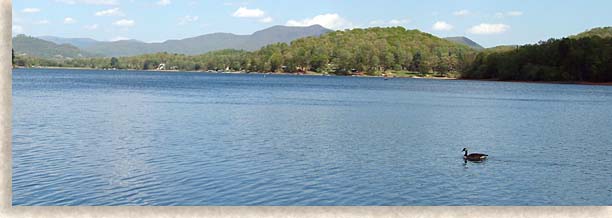
The mountains are not immune to troubles for the bird population. Disappearing habitats are probably the number one cause for the number of birds disappearing from this region; this is a matter of concern for wildlife agencies and should be a concern for local residents as well. Everyone’s conscious efforts benefit all who share their world with species who are endangered.
With the matters of wildlife bird survival addressed, and how the bird watching movement has evolved, this Blue Ridge Highlander feature story now moves onto the joys of being an avid or amateur bird watcher here in the Blue Ridge and Smoky Mountains.
With the vast amount of bird species in these ancient mountains, we’ll look at just a few of these fascinating creatures including a large list of some of the birds you’ll find here in the higher altitudes of the southeastern United States, plus a couple of flying oddities to examine.
Keep in mind not all bird life flies or soars, and not all that flies or soars are birds. Turkeys don’t fly well, ostriches don’t fly at all, and penguins only swim, waddle and slide.
In the evening, at dust, bats dominate the air, flapping around, looking kind of creepy, eating necessary insects although they don’t tangle themselves up in young ladies hair as superstitions have suggested. Bats are a common sight here in the mountains, they’re good for the environment and technically...they do actually fly.
What aren’t a common sight and are described as capable of flying but technically can’t, are flying squirrels. Nocturnal in nature these little smooth coated squirrel-like creatures are very reclusive. It’s my belief most of the human population who either reside here full time or visit these mountains have never seen one of these mysterious creatures, where as I have seen several.
My first encounter was in a mountain top cabin. The two doors in the front sunroom were open, each door leading to separate decks. We noticed one of our house cats studying the curtain rod above the door. As I approached the sunroom, I noticed a small squirrel like mammal perched on the curtain rod, as I moved toward the little critter he, she or it swooped off the rod toward the other open door 14 feet away and scurried away. As he leaped I saw him stretch out all four limbs and slowly defy gravity before making his landing and great escape, it even spooked the cat. I saw that same flying squirrel just once more on the front deck a few days later then he was gone; he likely moved on, hid well or became subject of one of the many flying feather predators that hung around the mountaintop.
A few years later I was living in the Cohutta Mountain region on the Georgia, Tennessee state line. There was a shed on the property and one day during the winter I saw a flying squirrel in the shed. I saw that squirrel there many times, then, there was two shacked up in the shed for the winter, The next winter there were five of more living in there. They were so use to me coming in and out of the shed they would approach within three feet of me to see what I was doing. I never notice any of them outside the shed and was never able to photograph them in actual flight.
What’s known about flying squirrels is that they are nocturnal creatures whose daredevil feats are seldom seen. They can soar across the air up to 150-foot distance to the ground after leaping from a branch 60-feet up a tree. A fold of hide or skin connects their hind and forelegs. When they leap they spread their four legs outward, the folds of skin act like a parachute that can be maneuvered, controlling its speed, angle and distance, capable of dodging limbs along their flight.
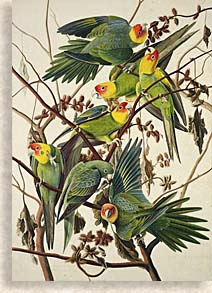 Another oddity in the mountain bird world most folks aren’t aware of is the now extinct North Carolina Parrot or Parakeet, an exotic tropical bird that once live in the Carolina’s. Though beautiful, new comers to America found them troublesome. They eat everything that grew, especially what the farmer grew. Due to their unpopularity they were driven off, trapped and mostly shot into extinction, today these birds would be on the wildlife protection list.
Another oddity in the mountain bird world most folks aren’t aware of is the now extinct North Carolina Parrot or Parakeet, an exotic tropical bird that once live in the Carolina’s. Though beautiful, new comers to America found them troublesome. They eat everything that grew, especially what the farmer grew. Due to their unpopularity they were driven off, trapped and mostly shot into extinction, today these birds would be on the wildlife protection list.
Thunderbirds once ruled the skies over North 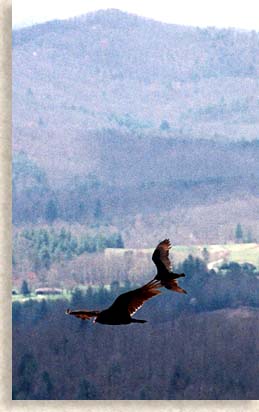 America. These legendary winged giant of the mountains found in most Native American tales are extinct if they ever did exist at all (some believe these might have been prehistoric Pterodactyls or type of descendent.) Legend tells us, the “Great Spirit” destroyed them after tribal clans petitioned their creator for their removal due to the fact the giant birds were attacking and carrying off their children.
America. These legendary winged giant of the mountains found in most Native American tales are extinct if they ever did exist at all (some believe these might have been prehistoric Pterodactyls or type of descendent.) Legend tells us, the “Great Spirit” destroyed them after tribal clans petitioned their creator for their removal due to the fact the giant birds were attacking and carrying off their children.
Though extinct, these thunderbirds may have some remnants still living in the Blue Ridge, Smoky Mountains. These imposters may have taken on the disguise of the turkey buzzard, an enormous bird with over a 7-foot wingspan, and highly unattractive and plentiful. Often they are seen in flocks’, flying in circles around some dead or dying carcass on the ground, or you’ll find them gathering along the roadway feeding on some road kill.
They’re not known to be aggressive toward humans though I wouldn’t recommend making friends with one. Their size is intimidating when their wings are stretch fully extended and when standing their head can easily look over the hood of a full size vehicle. Yet unlike the fabled thunderbird, they seem more passive, guess they learned their lesson.
Birds in the Blue Ridge, Smoky Mountains
First, let’s cover a few of these migratory and residential mountain birds, some of their habits and descriptions starting with the largest, the Bald Eagle to the smallest, the Hummingbird.
 Though I have yet to witness the flight of a Bald Eagle here in the mountains they do exist in high rocky reaches or along bluffs and
Though I have yet to witness the flight of a Bald Eagle here in the mountains they do exist in high rocky reaches or along bluffs and  cliffs. Bald Eagles have a dark brown plumage with white head and tail-feathers; young bald eagles are almost completely black.
cliffs. Bald Eagles have a dark brown plumage with white head and tail-feathers; young bald eagles are almost completely black.
Golden Eagles also found in these mountains are more consistent in brownish-gold coloring from head to talon and are about the same size as bald eagles.
At full adult maturity, bald eagles have a wingspan of 7.5-feet and make their huge nest amongst the high cliffs. Due to over hunting and pollutants the bald eagle was place on the endangered list and are more rare in sightings.
Along Tennessee’s Holston Mountains (which are part of the Upper Unaka Mountain’s and are considered the oldest mountains located in the upper eastern corner of the state Tennessee.) Just below the western face of this ancient mountain range is Holston Lake. Along this lake’s eastern shoreline is a peninsula in the Little Oak Recreation Area, here a Bald Eagle Hacking Program is credited for releasing over 2-dozen bald eagles back into the wild.
The term “hacking” comes from falconry, is a method of gradual reintroduction of predator birds into the wild. Young eagles from ages 7-weeks to 13-weeks old are held in cages in the area for release into the wild. By imprinting the region into their natural senses, the hacking area will become their personal habitat once they are set free; here is where they will return year after year once they reach biological maturity. This breeding ground for future offspring makes this a great location for viewing these reclusive rarely seen symbols of our great nation. Inquire at the local Ranger District office to get recommendations for the best place for a chance viewing of these incredible birds.
Bald Eagle, symbol of a Nation...In 1789 George Washington became our 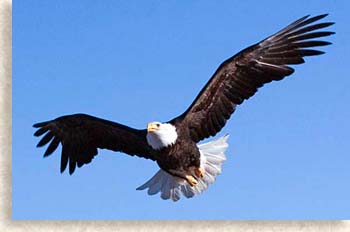 Nation’s first President; at the same time the American Bald Eagle became our Country’s official bird. Over 150 years later the American Bald Eagle was protected under the National Emblem Act of 1940, also known as the Bald Eagle Protection Act.
Nation’s first President; at the same time the American Bald Eagle became our Country’s official bird. Over 150 years later the American Bald Eagle was protected under the National Emblem Act of 1940, also known as the Bald Eagle Protection Act.
The bald eagle was additionally placed under the Endangered Species Act with stiff penalties imposed for killing, harassing, possessing or selling bald eagles including their highly prized feathers.
President John F. Kennedy wrote. “The Founding Fathers made an appropriate choice when they selected the bald eagle as the emblem of the nation. The fierce beauty and proud independence of this great bird aptly symbolizes the strength and freedom of America.
 Peregrine Falcons are predator birds whom nest amongst the high cliffs and steep bluffs of the Blue Ridge Mountain Province. For 4,000-years these great birds have had a unique relationship with humans as hunting birds. The Chinese and Persians civilizations perfected the technique of hunting game birds before being popularized by Medieval European noblemen.
Peregrine Falcons are predator birds whom nest amongst the high cliffs and steep bluffs of the Blue Ridge Mountain Province. For 4,000-years these great birds have had a unique relationship with humans as hunting birds. The Chinese and Persians civilizations perfected the technique of hunting game birds before being popularized by Medieval European noblemen.
The decline of the Peregrine falcons was due to insecticide introduced in the mid 20th century; those insecticides can remain in the soil for years. Discovering what was killing our nation’s bird population is what led to the ban of the pesticide DDT.
Only 60-nesting pairs were known to exist in the United States in the mid 1970’s. By 1993 there were 800 pairs counted due to the Falconry Hacking program’s highly successful releases of over 4,000-falcons.
Wild Turkeys are considered the most numerous of the five turkey subspecies. Mostly brownish-black tone in color, they prefer walking, capable of short flight to evade 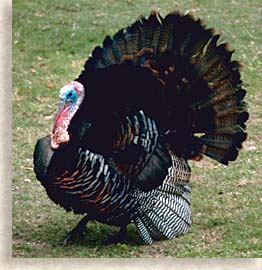 predators. The Native Americans chose not to eat the fowl because of there slow lumbering, easy to hunt nature. They believe the big bird was dim-witted and that by consuming the flesh of the bird would weaken their spirits, their feathers were used for decorations and still are use in head dresses due to strict laws prohibiting the obtainment of eagle feathers.
predators. The Native Americans chose not to eat the fowl because of there slow lumbering, easy to hunt nature. They believe the big bird was dim-witted and that by consuming the flesh of the bird would weaken their spirits, their feathers were used for decorations and still are use in head dresses due to strict laws prohibiting the obtainment of eagle feathers.
Wild Turkeys are known to have excellent eyesight, a built in protection devices to assist them in survival, they may appear slow but be assured they can see you coming. The new comers who arrived from Europe also discovered, they were easy to hunt and mighty tasty too. Early pioneers would drive large herds of wild turkeys through these mountains to market.
In downtown Asheville, North Carolina, there stands a monument in the fashion of an obelisk with bronzed life size statues of wild turkeys and hogs surrounding the obelisk, in honor of the drovers who once braved this difficult terrain. Today, wild turkeys are still found throughout these mountains, preferring both woodlands and open fields for foraging.
At the time when the bald eagle was considered for our national symbol, there were hot debates as to why the wild turkey, not the bald eagle should be chosen as the symbol of our nation. Supporting this theory were some of Colonial America’s most respected citizens.
In the year 1784, the elder statesman Benjamin Franklin found it necessary to register his own disregard for the bald eagle. Benjamin Franklin states, “The bald eagle…is a bird of bad moral character; like those among us who live by sharping and robbing, he is generally poor, and often very lousy. A coward, the little kingbird, not bigger than a sparrow attacks him boldly and drives him out of the district. He is therefore by no means a proper emblem for the brave and honest of America. The turkey, a bird of courage, would not hesitate to attack a grenadier of the British guards. The turkey is a much more respectable bird for America.”
Joining Mr. Franklin in this passionate opinion was artist John James Audubon who also agreed the Wild Turkey would have been the better choice.
Barred Owls and Screech Owls are popular yet seldom seen. At times, I have seen glances of 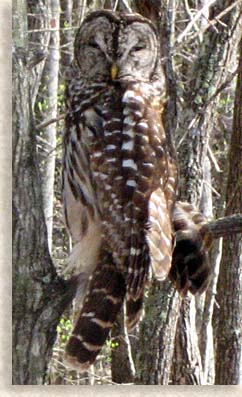 both large and small owls at late dusk or after dark while driving along the highway. They occasionally swoop across the roadway in pursuit of night prey passing in front of a vehicle’s headlights; I suppose they were using the high beams to assist their targeted prey.
both large and small owls at late dusk or after dark while driving along the highway. They occasionally swoop across the roadway in pursuit of night prey passing in front of a vehicle’s headlights; I suppose they were using the high beams to assist their targeted prey.
Being reclusive in nature and mostly active at night makes it difficult to capture a photo of them. One late evening as I headed out on foot to feed my K-9 family members while wearing a caving flashlight strapped around my head. A small owl sprung up from the ground to a low eye level tree branch. This owl was no bigger than the length of my hand from wrist to finger tip, he sat on the branch no more than six feet from me and was as interest in me as I was in him. We stood, (I stood he perched) and just looked each over for a while both equally curious, I turned my head towards the dogs for a moment and naturally the light followed my head and when I turned back he was no where in sight.
Prior to that Mrs. Highlander and I were hiking on our property, climbing the long high trail up the mountain behind the cabin. About half way up the mountain along the upper cove in the middle of the day Mrs. Highlander spotted on a low tree branch a residential Barred Owl. A very large owl, known to be very reclusive in nature, he, she or it just sat perched watching us without a care. Luckily we always at least carry a small pocket digital for such unexpected sightings. The owl gladly allowed us to approach within 10-feet, posed gracefully as his eyes followed my nearly 360-degrees path around the tree before he quickly snapped his head back around to the other side while continually observing my photo shoot. Several times since then we have seen him flying high up in the cove during the daytime in search of prey, and we hear him quite often. Obviously he feels very comfortable and secure in his nesting grounds.
 The Pileated Woodpecker is one of the most popular woodpeckers of the southern highlands and possibly the largest. Also known as the logcock, this species of large woodpecker is considered quite reclusive, often heard more than seen, though it is one species that I have personally witnessed many times. They are quite beautiful to watch even though they try to stay out of sight, moving quickly from one tree to another. In the springtime I have even notice several at a time flying together around the woods of our property. Pileated woodpeckers have a 30-inch wingspan making them quite large; they are most recognized by the red-topknot crown, otherwise they mostly have a black plumage with some white accents. Pileated woodpeckers make their nest in holes within large trees. The reason for all the pecking is to obtain the wood destroying insects they enjoy munching on, like carpenter ants, cockroaches, caterpillars and other wood-devouring insects. Woodpeckers are not destroying trees as much as eating the actual destroyers of tree, the insects.
The Pileated Woodpecker is one of the most popular woodpeckers of the southern highlands and possibly the largest. Also known as the logcock, this species of large woodpecker is considered quite reclusive, often heard more than seen, though it is one species that I have personally witnessed many times. They are quite beautiful to watch even though they try to stay out of sight, moving quickly from one tree to another. In the springtime I have even notice several at a time flying together around the woods of our property. Pileated woodpeckers have a 30-inch wingspan making them quite large; they are most recognized by the red-topknot crown, otherwise they mostly have a black plumage with some white accents. Pileated woodpeckers make their nest in holes within large trees. The reason for all the pecking is to obtain the wood destroying insects they enjoy munching on, like carpenter ants, cockroaches, caterpillars and other wood-devouring insects. Woodpeckers are not destroying trees as much as eating the actual destroyers of tree, the insects.
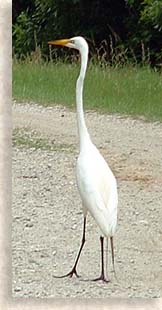 Egrets migrate to the mountains from their Coastal Plains nesting areas traveling hundreds of miles to their favorite fresh water mountain fishing wholes. Theses large magnificent white birds can be seen searching for fish and crustaceans along the banks of rivers, lakes and ponds as long as the warm season permits.
Egrets migrate to the mountains from their Coastal Plains nesting areas traveling hundreds of miles to their favorite fresh water mountain fishing wholes. Theses large magnificent white birds can be seen searching for fish and crustaceans along the banks of rivers, lakes and ponds as long as the warm season permits.
Passenger Pigeons once numbered in the millions throughout these mountains but were hunted to near extinction. You can still see some of these pigeons in cliff areas and also lining up along the roof tops of two the three story buildings in local mountain downtown areas or gathering along power lines. A common event you’ll find in just about any small or large metropolitan area. Pigeons are considered to be one of the most prehistoric bird types, and let us not forget a culinary delicacy also.
Red-Throated Hummingbirds are fascinating creatures. Hummingbirds and swifts are known as apodiform, classified as master of aerial locomotion. So tiny yet most aggressive when it comes to protecting their turf, so aggressive is their survival nature that they can drive off muchlarger birds from their feeding 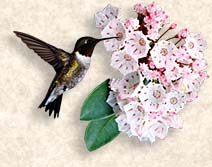 sites. So aggressive for their food source they constantly mix it up with other hummingbirds, driving one off while another swoops in to take its place, it’s fascinating to watch and no serious harm is inflicted, it a ritual dance that goes on day after day until they part for their migration to South America each year. They are so small their bodies are about the length of an average adult male’s thumb.
sites. So aggressive for their food source they constantly mix it up with other hummingbirds, driving one off while another swoops in to take its place, it’s fascinating to watch and no serious harm is inflicted, it a ritual dance that goes on day after day until they part for their migration to South America each year. They are so small their bodies are about the length of an average adult male’s thumb.
Hummingbirds prefer natural flower meadows for their essential nectar, but are attracted to red colored hummingbird feeders. It’s better to buy a red colored feeder and prepare your own mixture of organic sugar and water or at least read the ingredients and find a commercial brand that has no harmful artificial red dyes that can be found in commercial hummingbird nectars. If you choose to make your own, first boil 4 parts water, remove from the stove, stir in 1 part organic sugar and let cool.
Bird watching in the Blue Ridge, Smoky Mountains is a great reason for getting outdoors and encountering beautiful and often unusual wildlife, “Buena Vista Ya'll.”
Other Birds of the Blue Ridge Mountains
Scarlet Tanager, this branch hopping bird has a distinctive “chick-kurr” call.
Rufous-sided Towhee has a loud “drink-you-tea” song and is often found under brush or thicket.
Golden-Crowned Kinglet has a flitting and restless type movement and makes a high, thin ‘ssst’ sound.
Red-Tail Hawks are beautiful to see, they often perch plainly in sight while they daylight hunt small animals from the air or their exposed chosen perches.
Red-Billed Woodpecker is identified by its white stripe above red eyes and has an inclination for persistent singing.
Wood Thrush have a complex and beautiful series of brief phrases song that is interspersed with a high trill.
Hooded Warblers like to build its nest with a combination of bark, plant fibers, down grass and spider webs.
Cerulean Warbler, observing this species can be difficult due to the fact they usually prefer to feed high up in the trees.
Black-Capped Chickadee is between 5 to 6 inches long, has plumage of white and gray over its body with a black cap and throat, and sings a “fee-bee-fee” song
Northern Cardinal measuring 8-9 inches in length with a plumage of bright red crest and black mask, females are gray with red tail whose song is a “cheer, cheer, cheer” sound.
American Goldfinch is 4 to 5 inches long, its plumage is a bright yellow to drab olive body with white and black wings, whistling a “po-tato-chip or per-chick-oree” song.
American Robin is roughly 8 to 10 inches, whose plumage is a rusty-colored breast with a gray back and wings, its song sounds like “cherry or cheerio”
Mourning Dove is 9 to 13 inches, plumage beige colored body small head pointed tail, sings a somber “coo-ooh” song.
The Highlander
List of the Birds of the Blue Ridge and Smoky Mountains
![]()
Sign
up for the Blue Ridge Highlander Newsletter, Messages from the Mountains
to find out first about our new feature stories, road trips and special offers
Your e-mail addresses will not be sold or given away to anyone.
Privacy
Policy
Interested in your business being on the Highlander, click here...
Let our visitors tell you about the Highlander...
Click the feathers to go to the Highlander site
map...

